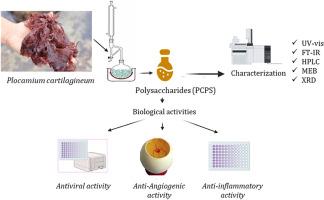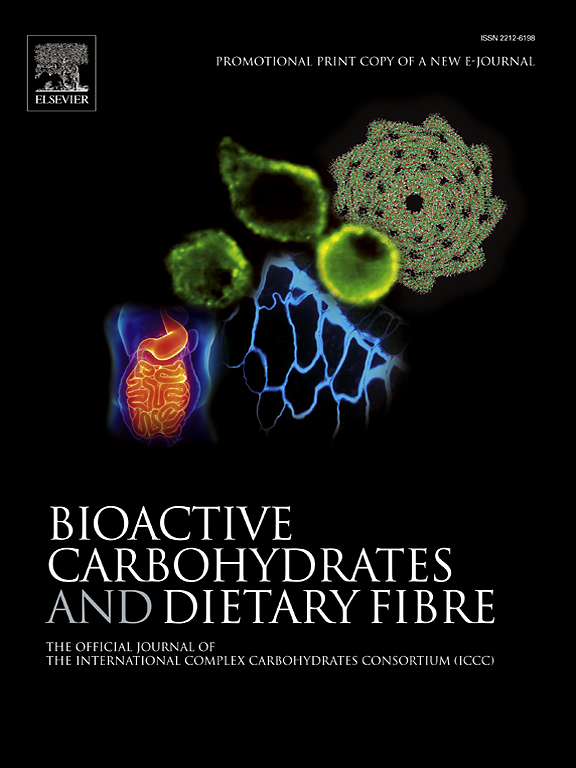红藻软骨Plocamium软骨Plocamium (Linnaeus) P.S. Dixon 1967中具有抗病毒、抗血管生成和抗炎活性的多糖的结构和化学特性
IF 3.6
引用次数: 0
摘要
海洋藻类在海洋生态系统中丰富,是生物活性化合物的宝贵来源。本研究报道了从摩洛哥红藻软骨藻中提取硫酸酸化多糖组分(PCPS)并进行了表征。对细胞壁硫酸酸化多糖(PCPS)的抗病毒、抗血管生成和抗炎活性进行了评价。通过测定总糖、蛋白质、醛酸、多酚和硫酸盐基团的含量,分析了ppps的生化组成。采用傅里叶变换红外光谱、紫外可见光谱、x射线衍射、扫描电镜、高效液相色谱-质谱联用等方法对提取液的结构特征进行了研究。pcp的提取率为11.63±0.13%,其中糖(72.06±0.18%)和硫酸盐(12.27±0.06%)。FTIR证实了硫酸化多糖的存在,而XRD则表明了半晶向无定形的转变。HPLC-MS鉴定出半乳糖、阿拉伯糖和葡萄糖,将ppps归类为杂多糖。PCPS对HSV-1具有较强的抗病毒活性(EC50 = 3.84±2.8 μg/mL),通过抑制磷脂酶A2和弹性酶(IC50分别为0.138和1.34 μg/mL)具有抗炎作用(IC50分别为0.138和1.34 μg/mL),并具有抗血管生成的特性,可使绒毛膜尿囊膜实验中的血管形成减少46.26%。这些发现突出了软骨假体多糖的药用潜力。本文章由计算机程序翻译,如有差异,请以英文原文为准。

Structural and chemical characterization of polysaccharides from the red alga Plocamium cartilagineum (Linnaeus) P.S. Dixon 1967 with antiviral, anti-angiogenic, and anti-inflammatory activities
Marine algae are abundant in marine ecosystems and represent a valuable source of bioactive compounds. This study reports the extraction and characterization of the sulfated polysaccharide fraction (PCPS) from the Moroccan red alga Plocamium cartilagineum. The antiviral, anti-angiogenic, and anti-inflammatory activities of the cell wall sulfated polysaccharide (PCPS) were evaluated. The biochemical composition of PCPS was analyzed by quantifying total sugar, protein, uronic acid, polyphenol, and sulfate group contents. The structural characteristics of the extract were investigated using Fourier transform infrared spectroscopy, ultraviolet–visible spectroscopy, X-ray diffraction, scanning electron microscopy, and high-performance liquid chromatography coupled with mass spectrometry. The extraction yield of PCPS was 11.63 ± 0.13 %, with sugars (72.06 ± 0.18 %) and sulfate groups (12.27 ± 0.06 %). FTIR confirmed the presence of sulfated polysaccharides, while XRD indicated a semi-crystalline to amorphous transition. HPLC-MS identified galactose, arabinose, and glucose, classifying PCPS as a heteropolysaccharide. PCPS exhibited strong antiviral activity against HSV-1 (EC50 = 3.84 ± 2.8 μg/mL), anti-inflammatory effects by inhibiting phospholipase A2 and elastase (IC50 = 0.138 and 1.34 μg/mL, respectively), and anti-angiogenic properties, reducing vessel formation in the chorioallantoic membrane assay by 46.26 %. These findings highlight the pharmaceutical potential of P. cartilagineum polysaccharides.
求助全文
通过发布文献求助,成功后即可免费获取论文全文。
去求助
来源期刊

Bioactive Carbohydrates and Dietary Fibre
Agricultural and Biological Sciences-Food Science
CiteScore
6.00
自引率
0.00%
发文量
38
期刊介绍:
 求助内容:
求助内容: 应助结果提醒方式:
应助结果提醒方式:


